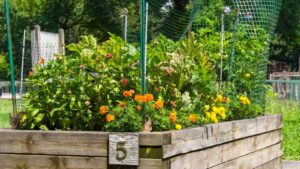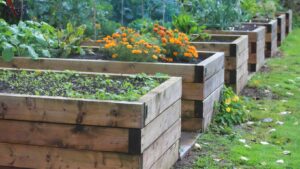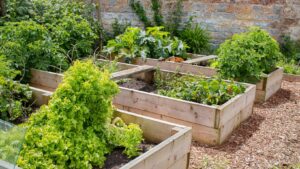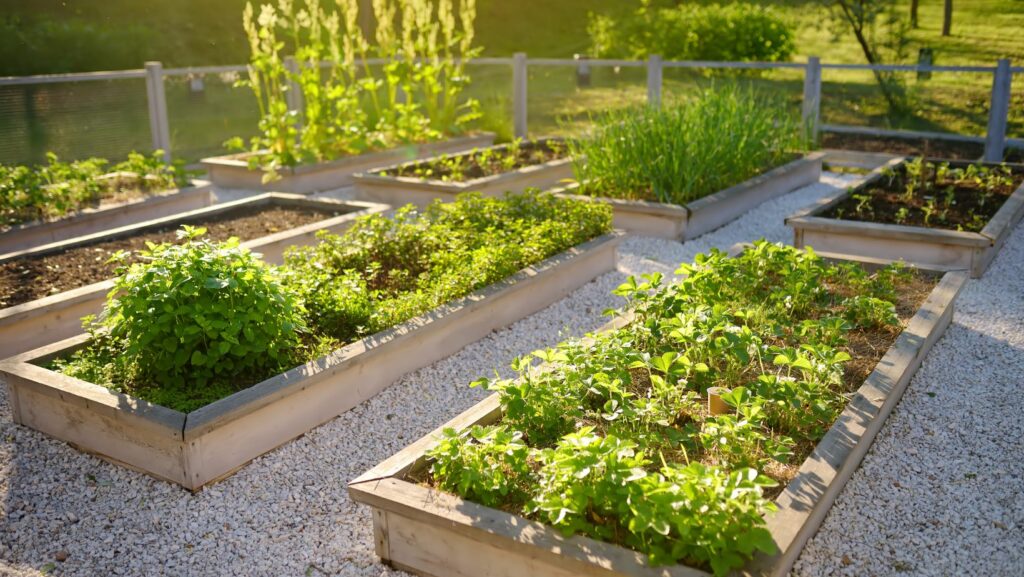Step into the world of organic gardening, where every plant is nurtured naturally and every harvest is a testament to sustainability. This article will delve into one of the most effective methods of organic gardening: raised beds.
Organic Gardening Raised Beds
 Organic gardening raised beds lead to improved soil health, as they encourage rich, lively soil teeming with beneficial organisms such as worms and microbes. These organisms not only promote plant growth, but also improve the soil’s structure and nutrient content. For example, a study by Cornell University reveals that raised bed gardens contain more beneficial organisms compared to traditional gardens.
Organic gardening raised beds lead to improved soil health, as they encourage rich, lively soil teeming with beneficial organisms such as worms and microbes. These organisms not only promote plant growth, but also improve the soil’s structure and nutrient content. For example, a study by Cornell University reveals that raised bed gardens contain more beneficial organisms compared to traditional gardens.
Secondly, raised beds offer easier accessibility, reducing the strain on gardeners’ backs and knees. As a table from the American Horticultural Therapy Association shows, raised beds are 24 inches high on average, making them accessible even for individuals with mobility issues.
Moreover, improved crop yields is another advantage of using raised beds. As confirmed by respected agronomic researchers, the strategic use of space in raised beds can lead to a 50% increase in vegetable yield compared to traditional row planting. This enables organic gardeners to maximize their space efficiently, fostering bumper harvests year after year.
Raised beds aren’t just about aesthetics or convenience; they provide substantial benefits from improved soil health to increased produce yields that make them truly valuable for organic gardening enthusiasts.
How to Set Up Organic Gardening Raised Beds
 Step 1: Choose the Suitable Location – Picking the right spot massively impacts raised bed growth. Sunlight exposure, water accessibility, and soil quality play crucial roles. Aim for a spot that gets 6 hours of direct sunlight daily, allowing the plants to photosynthesize adequately.
Step 1: Choose the Suitable Location – Picking the right spot massively impacts raised bed growth. Sunlight exposure, water accessibility, and soil quality play crucial roles. Aim for a spot that gets 6 hours of direct sunlight daily, allowing the plants to photosynthesize adequately.
Step 2: Select the Material – Materials like wood, concrete, or plastic are commonly used for crafting raised beds. Cedar and redwood resist rotting, making them excellent choices. However, keep in mind that plastic may degrade under the sun after a few years.
Step 3: Prepare the Ground – Clear the chosen area, remove any sod and weeds. You can place a weed barrier if the presence of deep-rooted specimens is suspected.
Step 4: Construct the Bed – Depending on purchased material, follow the manufacturer’s instructions for assembly. Remember, the bed’s height should be at least 6 inches, but 12 inches is optimal for root development.
Step 5: Fill the Bed – Mix rich, organic soil with well-aged compost for a nutrient-packed environment. This setting will ensure flourishing plant growth.
Step 6: Plant and Maintain – After setting up, it’s time to start planting. Maintenance primarily involves keeping the soil moist and managing weeds.
Impact of Organic Gardening Raised Beds on Environment
 Raised beds in organic gardening significantly reduce environmental impacts. They decrease water usage by up to 80% due to localized irrigation, an important factor in conserving an essential resource. Furthermore, raised beds enhance biodiversity by serving as habitats for beneficial creatures such as worms, beetles, and spiders. They manage to sequester about 0.4 tons of carbon per acre, an effective method of mitigating climate change. Their use of organic materials like compost, instead of synthetic fertilizers, reduces pollution in the air, soil, and water. Also, by increasing the vegetable yield by approximately 50% compared to conventional methods, they contribute to local food security, reducing reliance on transported goods and thus lowering carbon emissions.
Raised beds in organic gardening significantly reduce environmental impacts. They decrease water usage by up to 80% due to localized irrigation, an important factor in conserving an essential resource. Furthermore, raised beds enhance biodiversity by serving as habitats for beneficial creatures such as worms, beetles, and spiders. They manage to sequester about 0.4 tons of carbon per acre, an effective method of mitigating climate change. Their use of organic materials like compost, instead of synthetic fertilizers, reduces pollution in the air, soil, and water. Also, by increasing the vegetable yield by approximately 50% compared to conventional methods, they contribute to local food security, reducing reliance on transported goods and thus lowering carbon emissions.
Case Study: Successful Organic Gardening Raised Beds
Embracing organic gardening raised beds has proven to be a game-changer in the world of horticulture. It’s not just about the impressive 50% surge in vegetable yield. It goes beyond that. It’s the way these beds have revolutionized soil conditions and simplified garden maintenance. It’s how they’ve stepped up to the plate in the fight against environmental degradation, reducing water usage by a staggering 80%.
But that’s not all. These raised beds are champions of biodiversity, carbon sequestration, and pollution reduction. They’re using organic materials to make a difference. They’re contributing to local food security and cutting down on carbon emissions. They’re showing us that it’s possible to have a thriving garden and a healthy planet.

